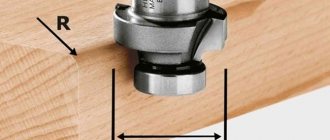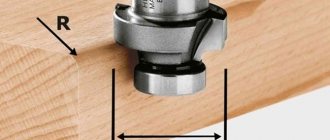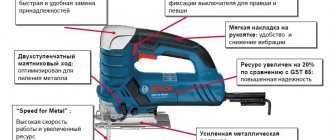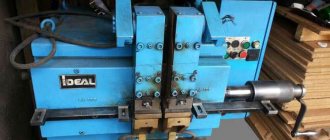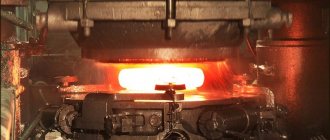Among the various metal processing techniques, milling has gained the most popularity. Milling can be used to work with workpieces made of materials of any strength and involves cutting layers of metal using a rotating cutter. Metal milling can be performed both on conventional machines and on equipment equipped with CNC, which allows producing products with minimal dimensional errors in a short time.
What is milling
In principle, hand-carved wood can be conditionally classified as milling. But there is a clear difference - only those types of processing that are carried out using a rotating cutter on manual or stationary machines are called milling.
If we exclude other simple woodworking techniques - sawing, hewing, planing, drilling, then there are two main directions in woodworking.
- turning - carving a rotating part to give the desired shape to the diameter of the part;
- milling – the formation of linear (not radial), longitudinal shapes.
The scope of application of milled parts is limitless. Such details can be found in many complex modern products. The operation is quite labor-intensive, but sometimes there is nothing to replace it with. Casting or stamping will not give accurate dimensions, or these methods cannot produce such complex formats. The only way left is milling.
Classification of milling work
There is no clear division of this type of processing due to the fact that the work you perform is very diverse.
There is a division by machine type:
- Laser processing.
- Milling machining.
The main types include the following:
- according to the location of the workpiece being processed - vertical, horizontal milling and milling at a certain angle;
- by type of cutter used - end, face, shaped, peripheral;
- in the direction of rotation of the cutting tool relative to the movement of the workpiece - counter or parallel.
The last type of classification is used for processing large workpieces, when the primary milling of the part is performed by the upstream type of processing, and the downstream type is used for final finishing.
Main technological stages
All milling work begins with determining the dimensions of the future part or product.
When milling with hand tools, mainly in woodworking, most often they work without drawings or even sketches. It is enough to imagine and understand the desired result and decide on the dimensions. The photo below shows the simplest wood milling, edge rounding:
In industrial production, drawings of the future product are necessarily used. Therefore, the milling machine operator must be able not only to operate the machine, but also to read drawings. A fairly high qualification of the machine operator is also required.
When working on modern CNC machines, electronic versions of drawings and appropriate software are required. Here the manual skills of the machine operator fade into the background. And the most important thing is competence in modern computer systems. Although manual work skills are also required - you need to install the cutter, place the workpiece, and control the processing process.
After determining the dimensions for any type of milling, a suitable cutter is selected and installed. The workpiece is placed on the work table and the actual processing takes place.
Accompanying phenomena
When milling, several points arise that can affect the quality of work:
- Shavings. If chips get into the contact zone where cutting occurs, it is fraught with defects. It can also damage the cutting edge.
- Hardening. An increase in the surface temperature of the workpiece reduces its strength, as a result the consumer properties of the finished product deteriorate.
- Friction and vibration. Natural processes that occur during the milling process. They slow down the processing speed and lead to wear on the cutter.
Types of milling on machines
There are three main types of milling.
- Terminal . It takes its name from the end mill used with the cutting end (end). It is used for making rectangular grooves, curved holes and windows, pockets and niches for various purposes.
- End _ This is the processing of large surfaces with cylindrical cutters with straight, fairly large cutting edges. The edges, side and horizontal surfaces and ends of workpieces are processed, which is why the operation is called end milling.
- Shaped . The most difficult type of processing. It can be used to manufacture products of any configuration. This could be the spiral teeth of a worm gear, a shaped sample of a wooden baseboard or railing. Milling cutters of various profiles are used, including prefabricated modular ones.
In metalworking, sometimes milling refers to cutting metal using a cutter. But such an operation can be performed in a large number of different ways, both in metal and woodworking, so the operation is conditionally classified as milling.
Industrial portal milling machine manufactured in 1978.
Benefits of technology
The key advantage of this technique is its versatility, since using different cutters and cutting technologies on one milling machine you can perform many procedures and work with metal, plastic, wood, caprolon, etc.
Depending on the shape of the workpiece, the cutting equipment used and the milling method, the machines allow you to perform the following types of manipulations:
- engraving and applying patterns of any complexity;
- cutting metal parts into several elements;
- grinding surfaces using special attachments with abrasive;
- drilling holes and grooves;
- carving;
- formation of modular surfaces, etc.
CNC
The machine tool industry today offers hundreds of options for a wide variety of CNC machines for processing any materials. From the smallest for small home workshops, to the most powerful for industrial production.
The main series of such machines:
- lungs;
- professional;
- industrial;
- special.
Light ones (among them the lightest) cost from 150 thousand rubles.
Professional is an intermediate option between light and industrial options. These include wood milling and engraving machines costing from 200 thousand rubles. up to 600 thousand rubles.
Industrial - for continuous production, cost more than 1 million rubles.
Special ones are most often designed individually for specific tasks and details. These include machines for milling stones, as well as small, ultra-precise ones for jewelry.
Technical problems of milling and ways to solve them
Despite the use of technologically advanced milling machines, this process may be accompanied by the emergence of a number of problems that have different reasons for their occurrence and solutions. One of the possible problems is injury to the operator from flying metal shavings, which is easily solved by organizing a system for its removal. But there are more significant problems for the milling process. These include an active reduction in the working life of the equipment and damage to the surface of the workpiece during processing.
Reduced tool life
This category of important technical and technological problems of milling includes:
- Rapid wear of the edge of the cutting equipment. As a rule, it occurs as a result of incorrect feeding of the material being processed, installation of inappropriate equipment or its rotation speed.
- Severe chipping of the edge of the cutter, caused by the wrong choice, installation of the spindle at a different angle, or too high a rotation speed. Also, the reasons for the formation of this problem can be caused by excessive pressure from the cutter or the poor condition of the surface being processed, which has not undergone the necessary preparation.
- Complete failure, which most often results from the use of a tool with insufficient strength and thermal shock. This problem can be avoided by using the right equipment and air or liquid cooling to regulate temperature and lubricate the work area. More rare causes of cutter failure include the absence or poor removal of chips, which leads to secondary cutting and transfer of an impressive load to the tool.
- The formation of build-up on the cutting edge and the adhesion of metal chips, which occurs when cutting soft metals (for example, aluminum) and using a cutter with an incorrectly selected angle. Solved by changing equipment.
Damage to the treated surface
The most common damage to workpiece material includes:
- The formation of hardening as a result of an increase in temperature in the cutting area with an increase in strength and a decrease in ductility. The situation can be avoided by using timely cooling of the part.
- Deviation from verticality, which usually occurs when the edge of the cutting equipment is heavily worn or when the cutting mode is incorrectly selected.
- Non-compliance with dimensions resulting from poor fixation, insufficient rigidity of the tool, unacceptable level of vibration or an increase in the replacement interval. The problem is corrected by changing the cutter, using a more rigid workpiece clamping force, and using vibration dampers.
- Chipping and the formation of unevenness, which are the result of incorrect setting of speed and depth, as well as lack of uniformity of feed of the workpiece.
A preliminary study of possible accompanying negative phenomena, their causes and solutions, will allow you to choose the right equipment and operating mode, which will generally affect the quality and productivity of the work process.
3D milling
Modern 3-6 axis 3D CNC machines have brought this method of processing various materials to a fundamentally new level. Today there are no parts that such machines cannot make. They even make sculptures with their help.
The most important points are the correct selection of cutters for different materials and the appropriate software. There is both free software on the market, including open source software for possible modification, and paid packages created specifically for the manufacture of specific parts and tasks.
Basic software standards: CAM System and CAD system
As an option, programs are offered for free testing for a month.
The capabilities of such a machine in woodworking can be seen in the following video:
Equipment
The main equipment, of course, is the milling machine itself or a hand router.
The main components are cutters for various purposes and profiles. However, there are no technological lines or small production facilities consisting of only one machine.
Before the workpiece is processed, it is most often prepared on other equipment.
- format cutting machines;
- miter or hand-held circular saws;
- gas cutting or laser cutting of metal.
Sometimes it is necessary to prepare the workpiece in terms of thickness. Then it is adjusted to the desired size using the following equipment:
- wood - trimming on circular saws or band saws, planing on a jointer or planer;
- metal – cutting to thickness in different ways, preliminary rough milling.
Stationary machines
In addition to the modern CNC machines described above, of which there are many, there are also simpler options.
These are the simplest wood milling machines, consisting of a table, a motor, a cutter landing shaft and a guide for manual feeding of the workpiece. There is also an option with installing a manual router into the table upside down.
More complex ones are industrial milling machines for wood and metalworking. They can have automatic feeding of workpieces, regulation of the position of the cutter, positioning of workpieces, etc. Quite a lot of these old machines, manufactured before the 21st century, are still in working order. Although there are fewer and fewer of them left.
Hand milling machines
This type of tool is sometimes called a "milling machine." This is so because a hand router is a completely self-sufficient tool. It has everything that a stationary machine has:
- own electric motor;
- rotating spindle with mount for different cutters;
- working platform with adjustable cutter immersion depth.
This tool is intended for manual work, so there is no point in comparing it with large industrial machines. The manual router copes with its tasks to the fullest extent. Moreover, it has its own number of advantages over stationary options:
- mobility , ability to work anywhere;
- the ability to process large-sized workpieces that do not fit on the desktop of stationary machines;
- great versatility . Unlike special machines, a manual milling machine can perform all basic operations for milling soft materials;
- affordability . The cost of a manual milling machine is tens, sometimes hundreds of times less than the cost of stationary machines;
- compactness . This router does not require large areas to operate and store. When they are not using it, it is simply removed to the side, freeing up space.
Modern manufacturers offer the widest selection of such tools of different power, from 350 W to 2500 W.
In addition to universal ones, there are also special-purpose models - lamella, edge, filler.
Milling cutters
This small detail makes a huge difference. The machine only serves its work, and it is the milling cutter that directly processes the material. Therefore, the quality of processing depends largely on the cutter. With hundreds of varieties of milling machines and different cutters available, thousands of varieties are used. The main difference is in three respects:
- Mounting method. Shell cutters have a hole in the middle and are mounted on the spindle (shaft) of the machine. The photo shows a shear cutter for woodworking with replaceable knives:
- Milling cutters with shanks are clamped in collets. In the photo, a set of such cutters for a hand router:
- Profile . Simple, straight and profile cutters of various configurations are used. Nozzles with straight cutting edges are used to make the same straight recesses. Profiles form a sample on the workpiece that repeats the profile of the cutter itself.
The exception is 3D CNC machines. They cut complex profiles and reliefs with a simple thin end mill. Profiles on the part are formed due to the mobility of the cutter itself in three coordinates.
On 4-6 axis machines, cutters not only move vertically and horizontally, but can also tilt.
Milling materials
The cutter material must be stronger than the material being processed. If this is not a problem for soft materials, then in metalworking special heavy-duty alloys are used to make cutters. Some machines are equipped with a system for lubrication of the machined surface and the cutter with an oil-water emulsion. It lubricates the cutting area, removes small chips and cools the cutter.
Tree
This is a soft material. It is processed both by hand milling machines and by powerful industrial machines.
A hand router can be used to do almost all types of milling work, but in small quantities.
On industrial machines, moldings are made in-line - lining, floorboards with a groove/tenon connection, baseboards, corners, round products in two passes with a semicircular cutter, etc.
Despite the softness of the material, cutters are made of hard alloys so that they retain their sharpness for a long time and are less abraded by friction. As a rule, these are “high-speed cutters”, alloys such as R6M5, R6MZ and R12 (HSS in Western markings) - steel containing tungsten, molybdenum and vanadium in different proportions.
Plywood
Plywood sheets are large-sized material of small thickness. Sometimes it is necessary to mill edges, cut out non-through and through ornaments, curved or straight lines. Hand-held routers are better suited for working with large sheets. It is better to move a small tool relative to the sheet than to move a bulky sheet relative to a stationary router.
For plywood, universal cutters are used (hardwood, plywood, MDF, etc.). The hard adhesive resins in plywood can dull the cutter faster than when working with wood. Therefore, it is better to use high-quality cutters made of harder alloys.
Furniture board
Furniture board is wood, wooden beams glued together. Processed in the same way as wood. If the sheet is large, it is better to use a hand router, as is the case with large sheets of plywood.
MDF, OSB, laminated chipboard (LDSP) and plain chipboard
These are materials containing wood similar in structure. They are based on crushed wood, sawdust or shavings, compressed and glued under pressure at a certain temperature with adhesive resins. The difference is in the size of the wood particles and the manufacturing method. They are milled in the same way as plywood. Either universal or special cutters for such materials are used.
It is extremely undesirable to allow the cutter to overheat to prevent burning of adhesive resins, wood and the release of acrid smoke. Overheating of the cutter is possible when the cutter moves too quickly, the speed is too high, or the cutting edge of the cutter is dull.
